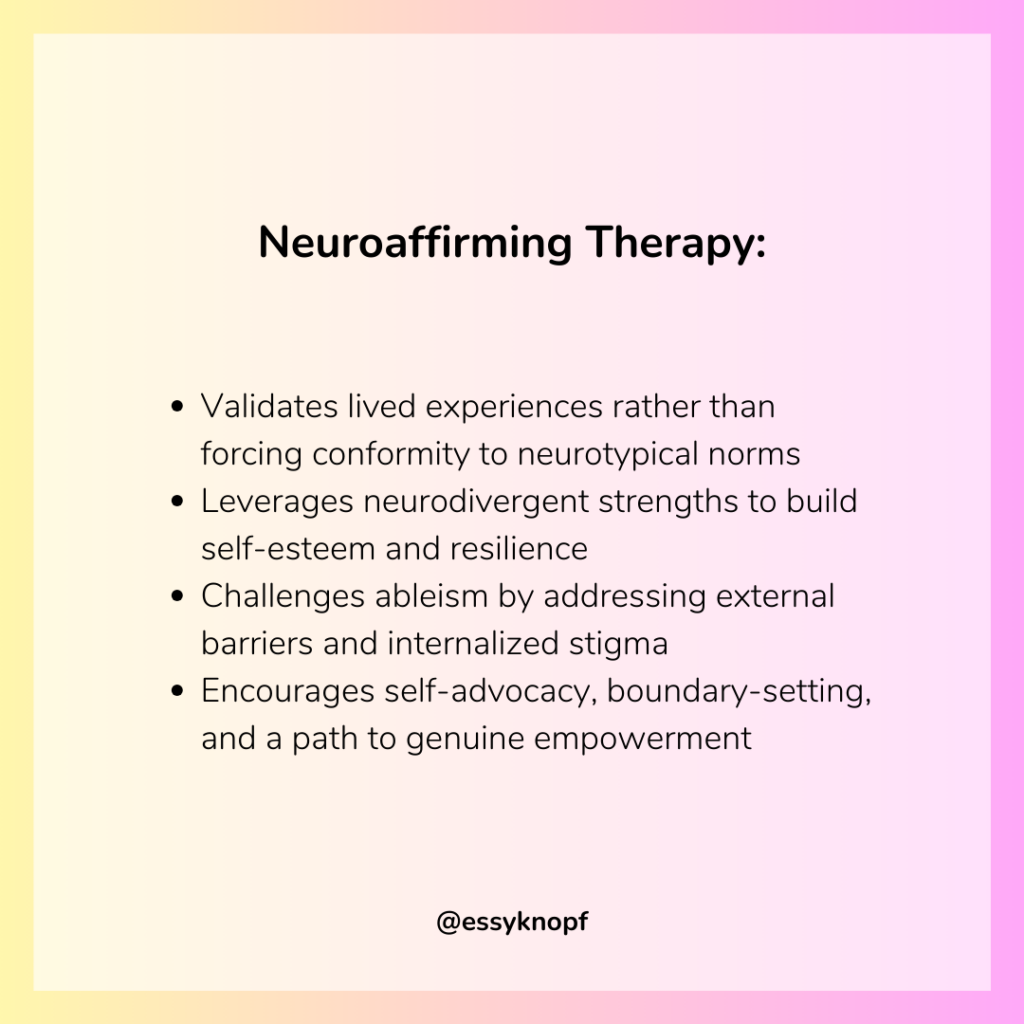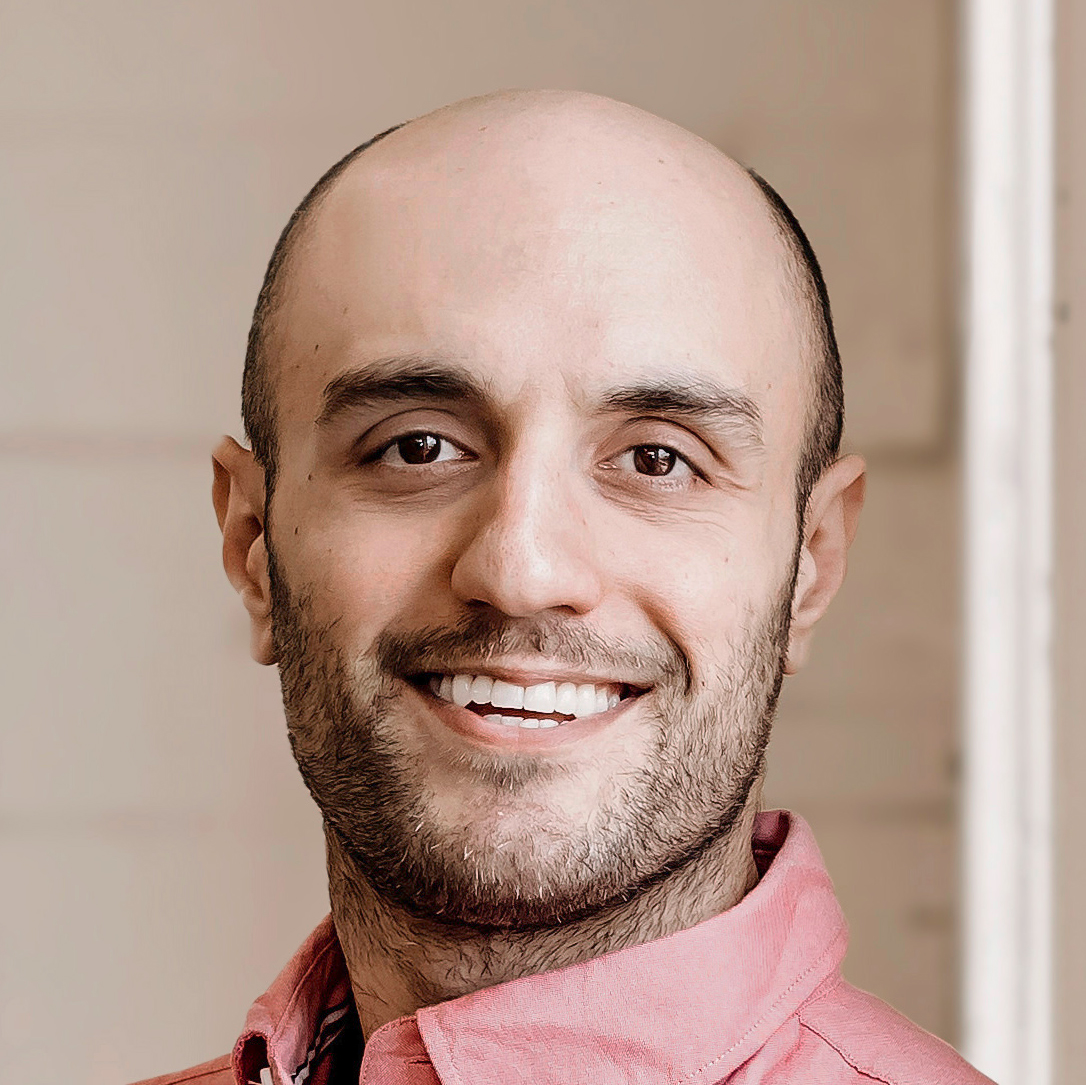Why neuroaffirming therapy is essential for autistic and ADHDers
If you’ve ever explained your autistic or ADHD-related challenges to a therapist, only to have them dismiss or misunderstand you, you’re not alone. Many neurodivergent (ND) individuals experience therapy that is based on neurotypical (NT) standards, failing to recognize their unique experiences and needs. This disconnect can be disheartening and even harmful, reinforcing feelings of alienation, self-doubt, and shame.
This is where neuroaffirming therapy (NAT) comes in. Unlike traditional therapeutic approaches that may view neurodivergence as a disorder to be fixed, NAT respects autism and ADHD as natural variations of human cognition. It focuses on validation, self-acceptance, and working with clients’ strengths rather than against their neurology.
NAT promotes an approach that acknowledges both the challenges and strengths of being ND, ensuring that therapy is tailored to the individual rather than forcing conformity to NT norms.
What is Neuroaffirming Therapy?
NAY is an attachment-based, trauma-informed, and strengths-focused approach that centers the lived experiences of autistic and ADHD clients. It acknowledges that many mental health struggles among NDs stem not from their neurotype itself, but from a world structured around NT expectations.
The stress of trying to navigate an environment that is not designed for them can lead to anxiety, depression, burnout, and masking—all of which NAT seeks to address with compassion and understanding.
Instead of forcing NDs to conform, NAT helps clients navigate the world while honoring their authentic selves. It challenges ableism, prioritizes self-compassion, and fosters empowerment. This approach helps clients build self-esteem, set boundaries, and advocate for accommodations that allow them to thrive.
How Neuroaffirming Therapy Differs from Traditional Therapy
Many traditional therapies operate within a deficit-based model, which assumes that NDs need to be “fixed” or trained to behave in NTs ways. This can result in harmful practices such as:
- Masking Encouragement – Encouraging NDs to suppress stimming, force eye contact, or change their communication style to fit neurotypical expectations.
- Pathologization of Traits – Viewing hyperfocus, sensory sensitivity, or direct communication as problematic rather than inherent ND traits.
- Invalidation of Experiences – Dismissing the impact of ableism and minority stress, attributing distress solely to the ND rather than their environment.
- Overemphasis on Social Norms – Prioritizing NT communication and behavior rather than helping NDs express themselves in ways that feel natural and comfortable.
NAT takes the opposite approach, recognizing that neurodivergence is a natural and valid way of being. Instead of trying to change the client, it seeks to support their unique needs and challenges by addressing external barriers, internalized ableism, and self-perception.
Core Principles of Neuroaffirming Therapy
Every ND is Unique
The saying “If you’ve met one autistic person, you’ve met one autistic person” holds true. Autism and ADHD manifest differently in everyone, meaning that therapy must be personalized to the individual’s needs, strengths, and intersectional identities (e.g., gender, race, sexuality, disability status).
Neurodivergence is Dynamic
Traits associated with autism and ADHD can fluctuate over time due to environmental factors, trauma, personal growth, and changing life circumstances. NAT recognizes that neurodivergence is not static but shaped by both genetics and lived experiences.
Pathology Often Co-Occurs
NAT does not pathologize neurodivergence itself, but it does acknowledge that conditions such as anxiety, depression, trauma, executive dysfunction, sensory processing disorder, and sleep disorders often co-occur and require compassionate, informed support.
Ableism is Pervasive and Harmful
Society is structured around NT norms, leading to systemic barriers that disadvantage NDs. NAT actively works to dismantle these barriers by advocating for accommodations, self-advocacy, community support, and radical acceptance.

Ableist Standards Are Internalized
Many NDs experience self-doubt and shame due to lifelong messaging that they are “wrong” or “deficient.” NAT helps clients unlearn internalized ableism, recognize their inherent worth, and embrace neurodivergence as part of their identity.
Ableism Creates Minority Stress
Living in a world that stigmatizes neurodivergence leads to chronic stress, burnout, and trauma. NAT provides a space where NDs can process these experiences without judgment and develop resilience through self-advocacy, community connection, and personal empowerment.
Complex PTSD is Common
Many NDs develop complex post-traumatic stress disorder (C-PTSD) due to chronic social rejection, bullying, masking, gaslighting, and misunderstandings. NAT helps clients recognize and heal from these traumas while rebuilding self-trust, emotional regulation skills, and coping mechanisms.
Rigidity is a Natural Response
NDs often develop rigid routines, preferences, and coping mechanisms as a way to navigate an unpredictable and often overwhelming world. Rather than labeling rigidity as a problem, NAT explores its origins and helps clients develop flexible, self-supportive strategies without forcing NT expectations.
Challenges Are Biopsychosocial
NAT acknowledges that difficulties faced by autistics and ADHDers arise from a combination of biological, psychological, social, and environmental factors—not just their neurotype. A comprehensive approach is necessary for effective support, which includes changing the environment, advocating for accommodations, building self-awareness, and challenging societal norms.
Why Neuroaffirming Therapy Matters
Traditional therapy often forces NDs to fit into NT frameworks, leading to further distress. NAT, however, takes an empowering, strengths-based approach that validates clients’ experiences and identities.
Therapists practicing NAT help clients understand that they are not broken or deficient—they are simply navigating a world not built for them. With the right support, they can learn to self-advocate, set boundaries, and cultivate a life that aligns with their authentic selves.
If you’re looking for a therapist, consider seeking out someone trained in NAT. And if you’re a therapist working with ND clients, integrating NAT principles can make a world of difference in your clients’ lives.
Want to Learn More?
Check out my book, The Neuroaffirming Therapy Handbook, or browse my blog for more insights into neurodiversity and mental health. If this post resonated with you, share it with others who might benefit!

Essy Knopf is a therapist who likes to explore what it means to be neurodivergent and queer. Subscribe to get all new posts sent directly to your inbox.
© 2025 Ehsan "Essy" Knopf. Any views or opinions represented in this blog are personal and belong solely to the blog owner and do not represent those of people, institutions or organizations that the owner may or may not be associated with in professional or personal capacity, unless explicitly stated. All content found on the EssyKnopf.com website and affiliated social media accounts were created for informational purposes only and should not be treated as a substitute for the advice of qualified medical or mental health professionals. Always follow the advice of your designated provider.


